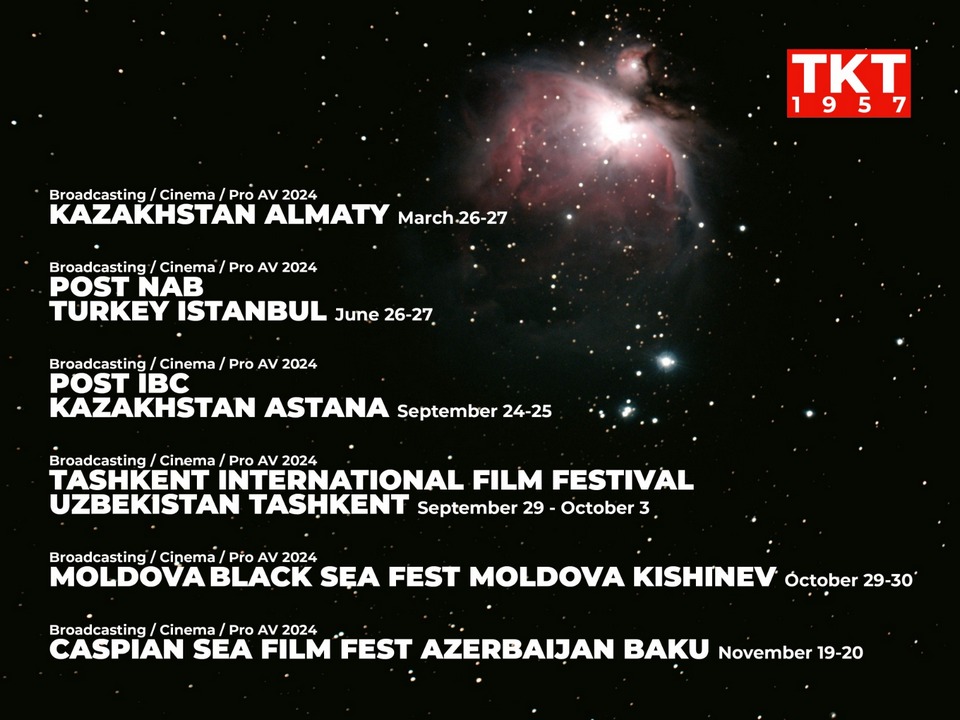
TVekstra took part in the renowned Broadcasting / Cinema / Pro AV conference held in Azerbaijan.
With a rich history of hosting successful events, the conference has become a key platform for companies to showcase their latest achievements and establish strategic alliances with industry influencers.
The conference provided TVekstra with the opportunity to network with key stakeholders, industry leaders, and technology enthusiasts. Actively participating in panel discussions, company experts, including Cengiz Icdem, Chief Technology Officer at TVekstra, shared ideas, strengthened their brand presence, and contributed to the development of the industry as a whole.
Cengiz Icdem: My name is Cengiz Icdem. I am the Chief Technology Officer at TVekstra. I have been working on software development projects for 25 years with several roles like developer, architect, team leader. I have five years of experience on HbbTV technology, especially in the field of addressable TV advertising.
TVekstra is a company in Turkey, which has an addressable advertising platform integrated with the biggest broadcasters, including Acun Medya, Demirören, Doğuş Media Group, Ciner Media Group, Turkuvaz Media Group, TRT and other minor broadcast groups. As a leader in HbbTV technology, we have reached more than 10 million households, achieving a penetration of 55 percent in TV. 60 TV channels is already active on the platform and the number is increasing.
We are committed to developing our own technology and software in the realm of addressable TV advertising. Our expertise includes the creation of our proprietary HBB playout software, which we deploy on the broadcasters’ local network or on the uplink center.
What is HbbTV?
HbbTV (Hybrid Broadcast Broadband TV) enables interaction with the television broadcast without the need for additional devices. Users can utilize their remote control buttons to interact with the TV broadcast. HbbTV technology is clickable. It provides the viewer to interact with the TV channel. Also it is measurable. All activities of the viewer can be measured, in similar to measuring the activities of a web site visitor.
Firstly, I will focus on the technical aspects of HbbTV, although I’ll keep the technical details straightforward and easy to understand. If you have any questions about the technology and its integration you may contact with us at info@tvekstra.com
Brief History of HbbTV
The HbbTV Consortium was founded in Europe in 2009, with its initial deployments occurring between 2010 and 2012, coinciding with the release of its first versions. The most significant expansion occurred between 2013 and 2016. There were similar organizations, like Open IPTV Forum and Smart TV Alliance from different parts of the world. These organizations came together under the HbbTV Association and started to work collaboratively. Additions to the specifications included HTML5, wider device support, MPEG-DASH, and DRM support.
Between 2017 and 2019, the technology expanded to support companion screens. ‘Companion screen’ refers to the ability of the television to communicate with mobile phones or tablets on the same WiFi network, allowing for interaction between the TV and these devices. This functionality also includes media synchronization between broadcast and broadband, meaning the broadcast stream could be synchronized with a stream from broadband.
From 2020 to the present, more improvements have been made like “dynamic ad insertion”, and “enhanced HTML5” functionality. Dynamic ad insertion is particularly crucial in smart TV technology. It allows for the replacement of linear TV advertisements according to the viewer’s profile, changing the advertisement dynamically.
How Does HbbTV Work?
In the usual flow of a broadcast transmission, broadcasters transmit their stream to an uplink center, which then relays the signal to satellites for reception by televisions. With the introduction of HbbTV, the broadband component becomes a significant part of the live broadcast. HbbTV connects the broadcast and broadband. When a hybrid terminal receives a stream from the satellite, it identifies the HbbTV application and activates the HbbTV engine. This engine communicates with the internet, connecting to the HbbTV application platform. HbbTV technology is equally applicable to all DVB transmissions, including satellite, cable and terrestarial networks.
When the TV receives the transport stream with HbbTV application URL in it, the HbbTV engine starts the HbbTV application in a browser that is in front of the broadcast window. You can think of the browser window as a second layer in front of the broadcast. The HbbTV application then decides which part of the browser window to fill and when to fill. It can display a banner on the lower part of the window. It can display an icon at the corner of the window or directly fill the full page (which is an unrequired situation for a viewer). Therefore the HbbTV application provider must get approval of the possible visual experiences from the broadcaster. In Turkey, we are in close contact with the TV broadcasters and always get their approval of any new visual expreriences or any visual assets that we are going to use in the advertisements. If the broadcaster does not approve the visual we do not publish it.
How do we enable HbbTV?
Before transferring the broadcast stream to the satellite (in the case of DVB-S), the optional tables that are carrying the necessary detail of HbbTV application must be embedded into the stream. This embedding process can be carried out using a “transport stream multiplexer,” either at the Broadcast company settlement or at the uplink center settlement. The following diagram displays how TVekstra HBB Playout Application integration works.
By default, the Transport Stream Multiplexer combines audio and video transport streams from multiple channels, along with various tables and service data like Electronic Program Guide (EPG). This multiplexed data is then delivered through satellite, cable, or terrestrial networks.
TVekstra HBB playout application produces a transport stream that includes the optional tables. The IT operator at the broadcast/uplink center company, matches the stream data received from the playout application with the audio and video streams using the multiplexer’s management interface. Then the final stream is transmitted to the broadcast channel.
HbbTV Marketing and Business Aspects
TVekstra’s main focus is selling addressable TV advertisements to brands and TV media agencies in Turkey. We provide an end-to-end service: receiving briefs from brands, creating visuals and graphics, receiving broadcaster approval, configuring campaigns on the platform, and generating post-campaign reports. This comprehensive service is designed to make life easier for all parties involved – the broadcasters, the media agencies, and the brands.
For the brands, we offer targeting options such as channel program targeting, city-country targeting, and time-coded planning. For our broadcasting partners, we provide real-time reporting and historical comparisons of TV channels. Also HbbTV advertisements generate extra ad revenue for the broadcaster.
What is an Addressable TV Ad?
Addressable TV advertising allows specific ads to be shown to targeted viewers. For example, when a viewer is watching traditional broadcast TV, a brand’s banner might appear at the bottom of the screen. If the viewer clicks the red button on their remote, the HbbTV application enlarges to full screen, showing more details of the brand’s campaign. After this interaction, the broadcast window reappears. There are various options for these landing pages.
Banner Interaction
Banners are displayed for 14 seconds. If the viewer doesn’t interact with the red button during this time, the banner disappears. However, if the viewer clicks the red button, indicating interest in the advertisement, a full-screen display appears. Viewers can return to the broadcast by clicking the red button again.
In Turkey, standard banners are typically lower brand banners or L-shaped banners. With an L-shaped banner, the size of the broadcast is reduced, but the entire broadcast is still visible. In contrast, with a standard banner, part of the broadcast may be obscured. Another example is the Info Band, which is smaller in size. For instance, a Gillette-sponsored banner might display the live score of a match. If the viewer does not interact with the red button, the banner disappears after 14 seconds. However, if the viewer presses the red button, the banner moves to the top and stays visible until the end of the match, allowing viewers to follow live scores without disconnecting from the broadcast. Another type is the right banner, which has a transparent background, enabling viewers to see most of the broadcast.
What can happen on a Landing Page?
After a viewer clicks the advertisement’s interaction button, several actions can occur on the landing page. Detailed campaign page can be displayed while the viewer continue to watch the broadcast in a smaller window. Also advertisement videos can be played instead of viewing the broadcast stream. We can also display lead forms where viewers can enter their mobile phone numbers, which can then be transferred to the brand’s APIs. For example, if I’m interested in a particular car model and want the brand to contact me, I can enter my mobile number. Simple games can be played. We can display QR codes may for scanning with mobile device camera and leading viewers to additional mobile site activities.
Time Coded Advertisement
We can use time-coded advertisements, like in the case of TV game shows where participants answer knowledge based questions. A lower band is displayed at the bottom of the screen, and viewers can give answer to the current question displayed on the broadcast using their remote control. For these type scenarios, we require the exact time when the presenter will ask the question from the broadcaster.
Audience Targeting and Analysis
We can implement audience targeting and analysis. “Income Level” , “Car Ownership” , “Demographic Details” are the basic examples for targeting criteria. Our campaigns can also be configured for detailed post-campaign reporting for brands and media agencies.
We have executed a campaign for BMW where there were two targeted audiences: Young Outward Achievement Oriented and Newly Married. For the former group, the focus is on the BMW 2 Series Gran Coupé, while the latter targets those interested in the New 5 Series Banner.
HbbTV Applications and Portals
Beyond addressable advertising, we offer HbbTV applications and portals. On the broadcast screen, we display icons that viewers can interact with for additional information about a brand or portal. By pressing the red button, viewers can open the Hbb portal. This portal may allow viewers to access catch-up services for the broadcast channel, enabling them to watch missed series or episodes directly on their TV. Additionally, the portal can display the broadcast schedule, offer games, and provide extra information like localized weather forecasts and exchange rates, depending on the viewer’s location, such as Baku for localized weather information. These features are subject to the business decisions of the broadcasters, and extra banners can also be displayed within the portal.
TV Analytics for Broadcasters
The final aspect is the analytics available to broadcasters. Since the HbbTV application runs on a browser, we can track statistics of TV channels in real-time. Our platform provides a dashboard displaying the realtime number of devices that are active on the TV channel, with comparisons between today, yesterday, and last week in 30 seconds intervals. Broadcasters also query historical traffic of their channels. And finally they can also monitor the reports of the advertisements displayed on their channels.










